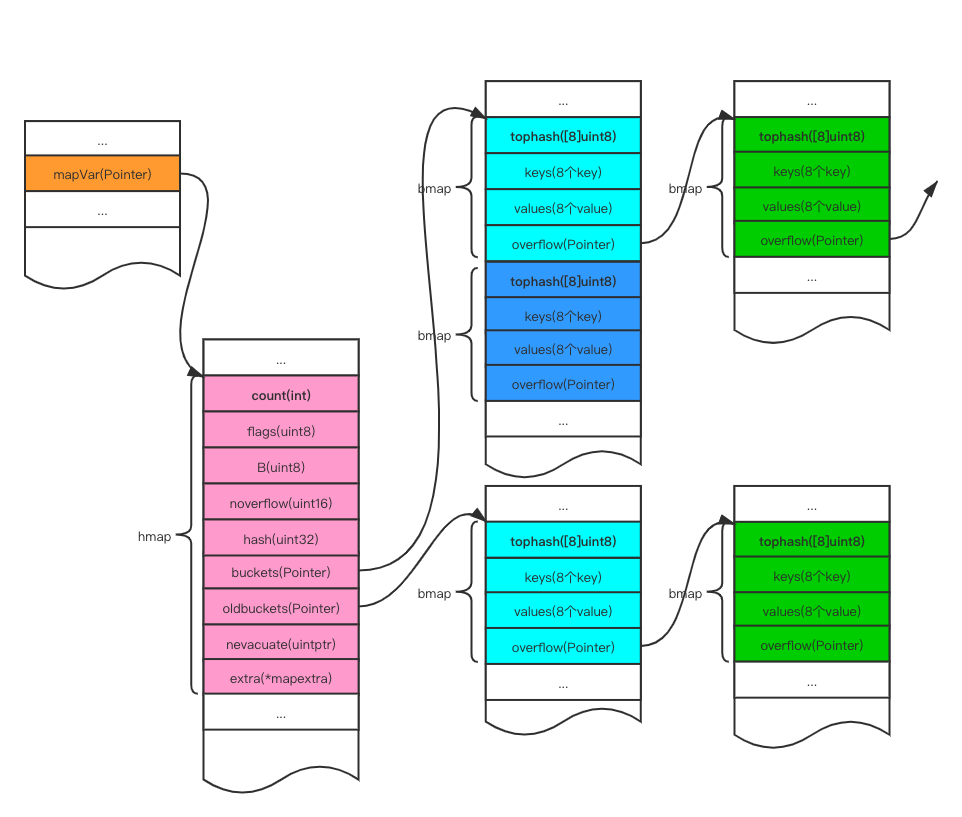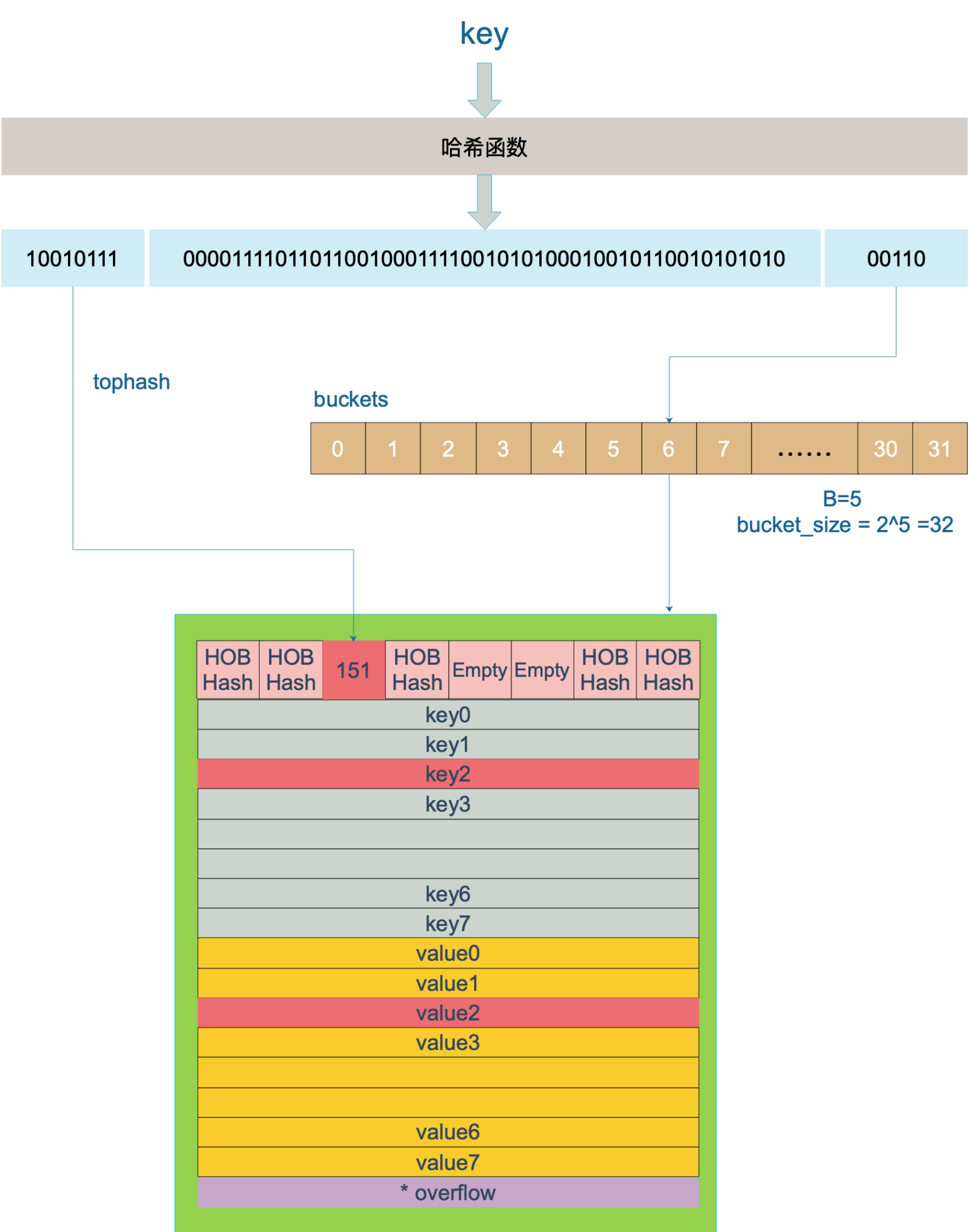Go 数据类型 | map 进阶
1.底层实现
map 是一个指针,指向 hmap 结构体。
1.1 hmap
// $GOROOT/src/runtime/map.go
type hmap struct {
count int // 代表哈希表中的元素个数,调用 len(map) 时,返回的就是该字段值。
flags uint8 // 状态标志(是否处于正在写入的状态等)
B uint8 // buckets 的对数。如果 B = 5,则 buckets 数组的长度 = 2^B = 32,意味着有 32 个桶。
noverflow uint16 // 溢出桶的数量
hash0 uint32 // 生成 hash 的随机数种子
// 指向 buckets 数组的指针,数组大小为 2^B,如果元素个数为 0,它为 nil。
// buckets 数组中每个元素都是 bmap 结构
buckets unsafe.Pointer
// 如果发生扩容,oldbuckets 是指向老的 buckets 数组的指针,
// 老的 buckets 数组大小是新的 buckets 的 1/2,
// 非扩容状态下,它为 nil。
oldbuckets unsafe.Pointer
nevacuate uintptr // 表示扩容进度,小于此地址的 buckets 代表已搬迁完成。
extra *mapextra // 存储一些额外信息。
}hmap 的 bucket 字段也是一个指针,指向的是底层的 bmap 数组。
1.2 bmap
// $GOROOT/src/runtime/map.go
// A bucket for a Go map.
type bmap struct {
// 长度为 8 的数组
// 用来快速定位 key 是否在这个 bmap 中
// 一个桶最多有 8 个槽位,如果 key 计算出来的 tophash 值在 tophash 数组中,则代表该 key 在这个桶中
tophash [bucketCnt]uint8
}每个 bmap 底层都采用链表结构。bmap 就是我们常说的“桶”,一个桶里面会最多装 8 个 key,这些 key 之所以会落入同一个桶,是因为它们经过哈希计算后,哈希结果的低 B 位是相同的。在桶内,又会根据 key 计算出来的 hash 值的高 8 位来决定 key 到底落入桶内的哪个位置(一个桶内最多有 8 个位置)。也就是说,tophash 字段存储了 key 哈希值的高 8 位。
此外,tophash 字段还会存储一些状态值,用来表明当前桶单元状态,这些状态值都是小于 minTopHash。
为了避免 key 哈希值的高 8 位值和这些状态值相等,产生混淆情况,所以当 key 哈希值高 8 位小于 minTopHash 时候,自动将其值加上 minTopHash 作为该 key 的 tophash。桶单元的状态值如下:
// $GOROOT/src/runtime/map.go
emptyRest = 0 // 表明此桶单元为空,且更高索引的单元也是空
emptyOne = 1 // 表明此桶单元为空
evacuatedX = 2 // 用于表示扩容迁移到新桶前半段区间
evacuatedY = 3 // 用于表示扩容迁移到新桶后半段区间
evacuatedEmpty = 4 // 用于表示此单元已迁移
minTopHash = 5 // key 的 tophash 值与桶状态值分割线值,小于此值的一定代表着桶单元的状态,大于此值的一定是 key 对应的 tophash 值
// tophash calculates the tophash value for hash.
func tophash(hash uintptr) uint8 {
top := uint8(hash >> (goarch.PtrSize*8 - 8))
if top < minTopHash {
top += minTopHash
}
return top
}在实际运行过程中,bmap 由 tophash 和连续的键、值数组组成,每个键值对占用一个槽位。overflow 存储的是指向溢出桶的指针,使用 uintptr 类型而非 *bmap 是为了避免被 GC 扫描到。类似于这样:
type bmap struct {
tophash [8]uint8
keys [8]keytype // 对应的键类型
values [8]elemtype // 对应的值类型
overflow uintptr
}
注意到 key 和 value 是各自放在一起的,并不是 key/value/key/value/… 这样的形式,当 key 和 value 类型不一样的时候,key 和 value 占用字节大小不一样,使用 key/value 这种形式可能会因为内存对齐导致内存空间浪费,所以 Go 采用 key 和 value 分开存储的设计,更节省内存空间。
1.3 mapextra
当 map 的 key 和 value 都不是指针类型时候,bmap 将完全不包含指针,那么 gc 时候就不用扫描 bmap。bmap 指向溢出桶的字段 overflow 是 uintptr 类型,为了防止这些 overflow 桶被 gc 掉,所以需要 mapextra.overflow 将它保存起来。如果 bmap 的 overflow 是 *bmap 类型,那么 gc 扫描的是一个个链表,效率明显不如直接扫描一段内存(hmap.mapextra.overflow)。
// $GOROOT/src/runtime/map.go
type mapextra struct {
overflow *[]*bmap // 指向 hmap.buckets 的溢出桶链表的指针
oldoverflow *[]*bmap // 指向 hmap.oldbuckets 的溢出桶链表的指针
nextOverflow *bmap // 指向空闲的溢出桶指针
}2.map 遍历为什么是无序的?
主要原因有 2 点:
- map 在遍历时,并不是从固定的 0 号 bucket 开始遍历的,每次遍历,都会从一个随机值序号的 bucket,再从其中随机的 cell 开始遍历;
- map 遍历时,是按需遍历 bucket,同时按需遍历 bucket 中和其 overflow bucket 中的 cell。但是 map 在扩容后,会发生 key 的搬迁,这造成原来落在一个 bucket 中的 key,搬迁后,有可能会落到其他 bucket 中了,从这个角度看,遍历 map 的结果就不可能是按照原来的顺序了。
要实现一个有序的 map,可以先用 slice 将 map 的 key 存起来并进行排序,之后遍历 slice 即可:
m := map[int]string{1: "a", 2: "b", 3: "c"}
var s []int
for k := range m {
s = append(sl, k)
}
sort.Ints(sl)
for _, k := range sl {
fmt.Println(k, m[k])
}3.map 为什么是非线程安全的?
map 默认是并发不安全的,同时对 map 进行并发读写时,程序会抛出 fatal error: concurrent map writes,原因如下:
Go 官方在经过了长时间的讨论后,认为 map 更应适配典型使用场景(不需要从多个 goroutine 中进行安全访问),而不是为了小部分情况(并发访问),导致大部分程序付出加锁代价(性能),决定了不支持。
要实现 map 线程安全,有 2 种方式:
- 使用 map + 锁
- 使用
sync.Map
4.map 的查找过程

4.1 写保护监测
首先会检查 map 的标志位 flags。如果 flags 的写标志位此时被置 1 了,说明有其他协程在执行“写”操作,进而导致程序 fatal,这也说明了 map 不是线程安全的。
// $GOROOT/src/runtime/map.go
if h.flags&hashWriting != 0 {
fatal("concurrent map read and map write")
}4.2 计算哈希值
// $GOROOT/src/runtime/map.go
hash := t.hasher(key, uintptr(h.hash0))key 经过哈希函数计算后,得到的哈希值如下(主流 64 位机下共 64 个 bit 位),不同类型的 key 会有不同的 hash 函数。
10010111 | 000011110110110010001111001010100010010110010101010 │ 010104.3 找到 hash 对应的 bucket
还记得我们前面讲的吗,bucket 存储了哈希值的低 B 个 bit 位,用来定位 key 所存放的 bucket。
如果当前正在扩容中,并且定位到的旧 bucket 数据还未完成迁移,则使用旧的 bucket(扩容前的 bucket)。
// $GOROOT/src/runtime/map.gp
// 计算哈希值,其中 t.hasher 是哈希函数,key 是键的指针,uintptr(h.hash0) 是一个哈希种子。
hash := t.hasher(key, uintptr(h.hash0))
// 计算桶掩码,bucketMask 函数返回值为 h.B 的二进制表示中最后 h.B 位的掩码。
m := bucketMask(h.B)
// 计算桶的地址,并将其转换为 bmap 类型指针。
// 其中 add 函数用于将两个指针相加,(hash&m) 是进行哈希取模的操作,t.bucketsize 是每个桶的大小。
b := (*bmap)(add(h.buckets, (hash&m)*uintptr(t.bucketsize)))
// 如果当前 map 正在进行扩容,并且新旧两个 map 桶的大小不相同,则需要额外处理。
if c := h.oldbuckets; c != nil {
if !h.sameSizeGrow() {
// 新旧两个 map 桶的大小比例为 2:1,因此原来的桶掩码 m 需要再右移一位,变成原来的一半。
m >>= 1
}
// 根据计算出的桶地址和掩码,计算出旧 map 的对应桶地址 oldb。
oldb := (*bmap)(add(c, (hash&m)*uintptr(t.bucketsize)))
// 如果这个旧桶已经被迁移到新的桶中,则不使用它,否则将其作为当前桶。
if !evacuated(oldb) {
b = oldb
}
}4.4 遍历 bucket 查找
tophash 值定位:哈希值的高 8 个 bit 位,用来快速判断 key 是否已在当前 bucket 中(如果不在的话,需要去 bucket 的 overflow 中查找)。
用步骤 2 中的 hash 值,得到高 8 个 bit 位,也就是 10010111,转化为十进制,也就是 151
// $GOROOT/src/runtime/map.gp
top := tophash(hash)
// $GOROOT/src/runtime/map.gp
func tophash(hash uintptr) uint8 {
top := uint8(hash >> (goarch.PtrSize*8 - 8))
if top < minTopHash {
top += minTopHash
}
return top
}上面函数中 hash 是 64 位的,goarch.PtrSize 值是 8,所以 top := uint8(hash >> (sys.PtrSize*8 - 8)) 等效 top = uint8(hash >> 56),最后 top 取出来的值就是 hash 的高 8 位值。
在 bucket 及 bucket 的 overflow 中寻找 tophash 值为 151 的槽位,即为 key 所在位置,找到了空槽位或者 N 号槽位,这样整个查找过程就结束了,其中找到空槽位代表没找到。
// $GOROOT/src/runtime/map.gp
bucketloop:
// 遍历 bucket 链表
for ; b != nil; b = b.overflow(t) {
// 遍历每个 bucket
for i := uintptr(0); i < bucketCnt; i++ {
if b.tophash[i] != top {
// 如果 tophash 值为 emptyRest,表示后续所有槽位都为空
if b.tophash[i] == emptyRest {
break bucketloop
}
continue
}
// 计算出 key 的地址
k := add(unsafe.Pointer(b), dataOffset+i*uintptr(t.keysize))
// 如果 key 是指针类型,需要进行解引用
if t.indirectkey() {
k = *((*unsafe.Pointer)(k))
}
if t.key.equal(key, k) {
// 计算出对应 value 的地址
e := add(unsafe.Pointer(b), dataOffset+bucketCnt*uintptr(t.keysize)+i*uintptr(t.elemsize))
// 如果元素是指针类型,需要进行解引用
if t.indirectelem() {
e = *((*unsafe.Pointer)(e))
}
return e
}
}
}
4.5 返回 key 对应的指针
如果通过上面的步骤找到了 key 对应的槽位下标 i,我们再分析下 key/value 值是如何获取的:
// $GOROOT/src/runtime/map.gp
// keys 的偏移量
dataOffset = unsafe.Offsetof(struct{
b bmap
v int64
}{}.v)
// 一个bucket的元素个数
bucketCntBits = 3
bucketCnt = 1 << bucketCntBits // 8
// key 定位公式
// bucket 里 keys 的起始地址就是 unsafe.Pointer(b) + dataOffset
// 第 i 个下标 key 的地址就要在此基础上跨过 i 个 key 的大小;
k := add(unsafe.Pointer(b), dataOffset+i*uintptr(t.keysize))
// value 定位公式
// 我们知道,value 的地址是在所有 key 之后,因此第 i 个下标 value 的地址还需要加上所有 key 的偏移。
e := add(unsafe.Pointer(b), dataOffset+bucketCnt*uintptr(t.keysize)+i*uintptr(t.elemsize))5.map 哈希冲突的解决方案
通过前面的介绍我们可以知道,map 哈希冲突的解决方案是使用链地址法。不过这里的链表单元并不是一个元素,而是桶。
6.map 负载因子
负载因子(load factor),用于衡量当前哈希表中空间占用率的核心指标。主要目的是为了平衡 buckets 的存储空间大小和查找元素时的性能高低。
6.1 Go 1.17 及更早版本
默认的负载因子是 6.5。这是 Go 官方的经过认真的测试得出的数字,一起来看看官方的这份测试报告。
报告中共包含 4 个关键指标,如下:
| loadFactor | %overflow | bytes/entry | hitprobe | missprobe |
|---|---|---|---|---|
| 4.00 | 2.13 | 20.77 | 3.00 | 4.00 |
| 4.50 | 4.05 | 17.30 | 3.25 | 4.50 |
| 5.00 | 6.85 | 14.77 | 3.50 | 5.00 |
| 5.50 | 10.55 | 12.94 | 3.75 | 5.50 |
| 6.00 | 15.27 | 11.67 | 4.00 | 6.00 |
| 6.50 | 20.90 | 10.79 | 4.25 | 6.50 |
| 7.00 | 27.14 | 10.15 | 4.50 | 7.00 |
| 7.50 | 34.03 | 9.73 | 4.75 | 7.50 |
| 8.00 | 41.10 | 9.40 | 5.00 | 8.00 |
- loadFactor:负载因子,也有叫装载因子。
- %overflow:溢出率,有溢出 bukcet 的百分比。
- bytes/entry:平均每对 key/value 的开销字节数.
- hitprobe:查找一个存在的 key 时,要查找的平均个数。
- missprobe:查找一个不存在的 key 时,要查找的平均个数。
Go 官方发现:装载因子越大,填入的元素越多,空间利用率就越高,但发生哈希冲突的几率就变大。反之,装载因子越小,填入的元素越少,冲突发生的几率减小,但空间浪费也会变得更多,而且还会提高扩容操作的次数。
根据这份测试结果和讨论,Go 官方取了一个相对适中的值,把 Go 中的 map 的负载因子硬编码为 6.5,这就是 6.5 的选择缘由。
这意味着在 Go 1.17 及更早版本中,当 map存储的元素个数大于或等于 (6.5 * 桶个数)时,就会触发扩容行为。
6.2 Go 1.18 ~ 1.20
Go 1.18 后,map 的负载因子是根据实际的哈希表性能来动态调整的。map 的负载因子调整分为两个方面:添加元素时的扩容和删除元素时的缩容。
在添加元素时的扩容阶段,当 map 中的元素个数达到当前桶数量和负载因子的乘积时,Go 的 map 实现会进行负载因子调整。具体调整步骤如下:
- 计算当前哈希表的性能指标,主要是通过测量平均查找时间来评估;
- 如果当前哈希表的平均查找时间小于桶的填充因子(即平均查找时间小于等于 6.5),则会增加负载因子,具体增加的比例为当前负载因子的 5%;
- 根据新的负载因子重新计算桶的数量,保证桶的数量为 2 的幂次方。
在删除元素时的缩容阶段,当 map 中的元素个数小于当前桶数量和负载因子的乘积的一半时,会进行负载因子调整。具体调整步骤如下:
- 计算当前哈希表的性能指标,同样是通过测量平均查找时间来评估;
- 如果当前哈希表的平均查找时间小于桶的填充因子(即平均查找时间小于等于 6.5),则会减少负载因子。具体减少的比例为当前负载因子的 5%;
- 根据新的负载因子重新计算桶的数量,保证桶的数量为 2 的幂次方。
7.map 扩容
在向 map 插入新 key 的时候,会进行条件检测,符合下面这 2 个条件,就会触发扩容:
// GOROOT/src/runtime/map.go
if !h.growing() && (overLoadFactor(h.count+1, h.B) || tooManyOverflowBuckets(h.noverflow, h.B)) {
hashGrow(t, h)
goto again // Growing the table invalidates everything, so try again
}
// 扩容条件 1:是否正在扩容
func (h *hmap) growing() bool {
return h.oldbuckets != nil
}
// 扩容条件 2:超过负载,map 元素个数 > 6.5 * 桶个数
// bucketCnt = 8,一个桶可以装的最大元素个数
// loadFactor = 6.5,负载因子,平均每个桶的元素个数
// bucketShift(B): 桶的个数
func overLoadFactor(count int, B uint8) bool {
return count > bucketCnt && uintptr(count) > loadFactorNum*(bucketShift(B)/loadFactorDen)
}
// 扩容条件 3:溢出桶太多
// 当桶总数 < 2^15 时,如果溢出桶总数 >= 桶总数,则认为溢出桶过多。
// 当桶总数 >= 2^15 时,直接与 2^15 比较,当溢出桶总数 >= 2^15 时,即认为溢出桶太多了。
// 可以看作对条件 2 的补充,因为在负载因子比较小的情况下,有可能 map 的查找和插入效率也很低,而第 2 点识别不出来这种情况。
func tooManyOverflowBuckets(noverflow uint16, B uint8) bool {
// If the threshold is too low, we do extraneous work.
// If the threshold is too high, maps that grow and shrink can hold on to lots of unused memory.
// "too many" means (approximately) as many overflow buckets as regular buckets.
// See incrnoverflow for more details.
if B > 15 {
B = 15
}
// The compiler doesn't see here that B < 16; mask B to generate shorter shift code.
return noverflow >= uint16(1)<<(B&15)
}7.1 扩容机制
双倍扩容:针对条件 2,新建一个 buckets 数组,新的 buckets 大小是原来的 2 倍,然后旧 buckets 数据搬迁到新的 buckets。
等量扩容:针对条件 3,并不扩大容量,buckets 数量维持不变,重新做一遍类似双倍扩容的搬迁动作,把松散的键值对重新排列一次,使得同一个 bucket 中的 key 排列地更紧密,节省空间,提高 bucket 利用率,进而保证更快的存取。
7.2 扩容函数
// $GOROOT/src/runtime/map.go
//
func hashGrow(t *maptype, h *hmap) {
// 如果达到条件 2,那么将 B 值加 1,相当于是原来的 2 倍
// 否则对应条件 3,进行等量扩容,所以 B 不变
bigger := uint8(1)
if !overLoadFactor(h.count+1, h.B) {
bigger = 0
h.flags |= sameSizeGrow
}
// 记录老的buckets
oldbuckets := h.buckets
// 申请新的buckets空间
newbuckets, nextOverflow := makeBucketArray(t, h.B+bigger, nil)
// 注意 &^ 运算符,这块代码的逻辑是转移标志位
flags := h.flags &^ (iterator | oldIterator)
if h.flags&iterator != 0 {
flags |= oldIterator
}
// commit the grow (atomic wrt gc)
// 提交 grow
h.B += bigger
h.flags = flags
h.oldbuckets = oldbuckets
h.buckets = newbuckets
// 搬迁进度为 0
h.nevacuate = 0
// 溢出桶数量为 0
h.noverflow = 0
// 如果发现 hmap 是通过 extra 字段来存储溢出桶时
if h.extra != nil && h.extra.overflow != nil {
// Promote current overflow buckets to the old generation.
if h.extra.oldoverflow != nil {
throw("oldoverflow is not nil")
}
h.extra.oldoverflow = h.extra.overflow
h.extra.overflow = nil
}
if nextOverflow != nil {
if h.extra == nil {
h.extra = new(mapextra)
}
h.extra.nextOverflow = nextOverflow
}
// the actual copying of the hash table data is done incrementally
// by growWork() and evacuate().
}上面的 hashGrow() 函数实际上并没有真正地“搬迁”,它只是分配好了新的 buckets,并将老的 buckets 挂到了 oldbuckets 字段上。真正搬迁 buckets 的动作在 growWork() 函数中,而调用 growWork() 函数的动作是在 mapassign 和 mapdelete 函数中。也就是插入或修改、删除 key 的时候,都会尝试进行搬迁 buckets 的工作。先检查 oldbuckets 是否搬迁完毕,具体来说就是检查 oldbuckets 是否为 nil。
由于 map 扩容需要将原有的 key/value 重新搬迁到新的内存地址,如果 map 存储了数以亿计的 key/value,一次性搬迁将会造成比较大的延时,因此 Go map 的扩容采取了一种称为渐进式的方式,原有的 key 并不会一次性搬迁完毕,每次最多只会搬迁 2 个 bucket。
func growWork(t *maptype, h *hmap, bucket uintptr) {
// 为了确认搬迁的 bucket 是我们正在使用的 bucket
// 即如果当前 key 映射到旧的 bucket,那么就搬迁该 bucket。
evacuate(t, h, bucket&h.oldbucketmask())
// 如果还未完成扩容工作,则再搬迁一个bucket。
if h.growing() {
evacuate(t, h, h.nevacuate)
}
}本作品采用《CC 协议》,转载必须注明作者和本文链接



 关于 LearnKu
关于 LearnKu




推荐文章: